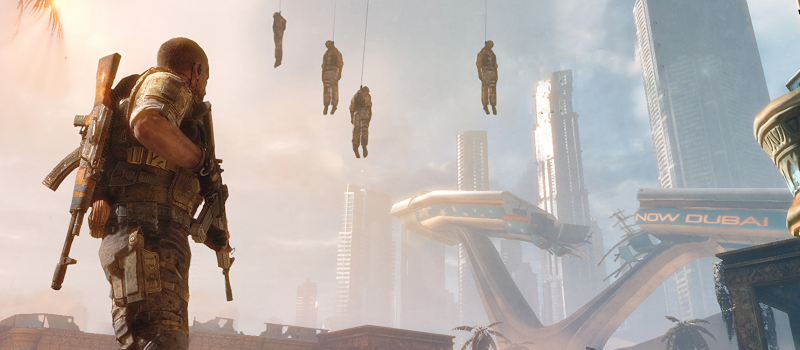
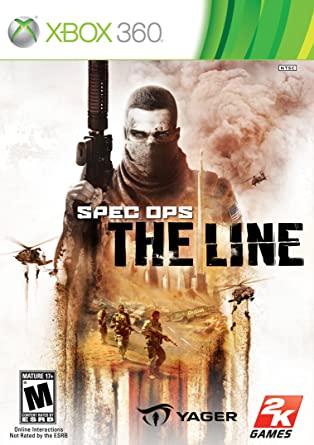
“None of this would have happened if you’d just stopped. But on you marched. And for what?”
2K Games audaciously promoted third-person military shooter Spec Ops: The Line as the Apocalypse Now of videogames. The game sets it aims high—instead of going for the primal engagement of mindless modern shooting games, it attempts to draw the player in with a gutsy story that deals with the mental and emotional trauma of real soldiers and the moral quandaries that they face. Forcing the player to reflect on the violence they are carrying out against other “humans” is a noble idea—one that the films that inspired the game explore to varying effect—but in a game where the goal of ~90% of the playtime is to shoot and kill everything that moves, the message gets a bit muddled.
Indeed, it suffers from the same problem that Francis Ford Coppola sees when Apocalypse Now gets labeled as anti-war. Interviewed by Kevin EG Perry for The Guardian, Coppola says, “No one wants to make a pro-war film, everyone wants to make an anti-war film. But an anti-war film, I always thought, should be like The Burmese Harp—something filled with love and peace and tranquility and happiness. It shouldn’t have sequences of violence that inspire a lust for violence. Apocalypse Now has stirring scenes of helicopters attacking innocent people. That’s not anti-war.”
Anyway, despite a cinematic bent, it’s probably best to think of Spec Ops: The Line among its videogame peers. Instead of stacking it against all the classic films its creators cited as inspirations (lead writer Walt Williams also listed Full Metal Jacket and Platoon), we should compare it to its contemporary shooter titles, many of which are narratively weightless and have no philosophical position at all. There’s no problem with that, of course; many great games are great because of their mechanics and aesthetics, and many almost-great ones simply needed to tamper down their inane and obtrusive storytelling.
And but so Spec Ops: The Line plays like many other sturdy third-person shooters you’ve tried before, but sets itself apart with its somewhat literary approach. As you move through the campaign, a Delta Force recon mission in a post-catastrophe Dubai, you’ll be faced with numerous decisions where either choice feels morally wrong. You’ll encounter charred bodies, rotting corpses hanging by the neck, and mutilated soldiers that will make your skin crawl. While you tear through the abandoned, sand-coated city, a story unfolds with the intent to make the player question their actions and their predilection for violence (but never strongly enough to stop you from loading up the next chapter and plugging every living thing between you and the next checkpoint).
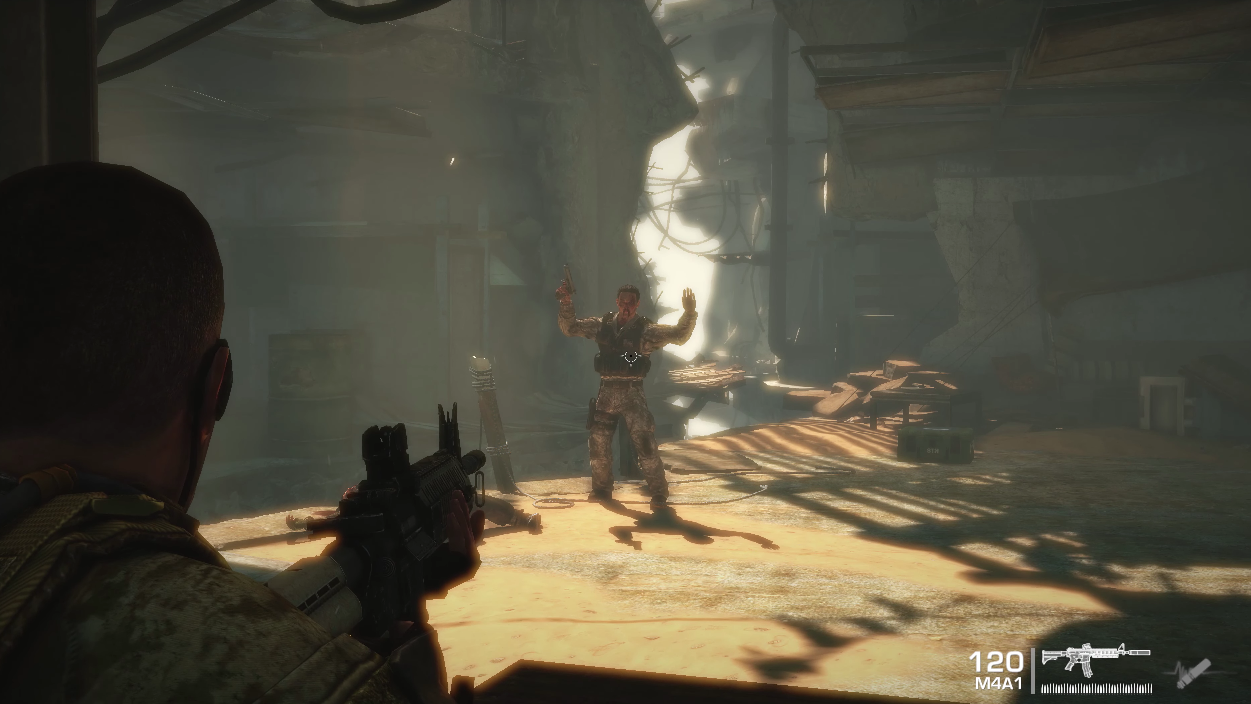
The setting is one of the game’s strong points. Dubai is like Rapture from Bioshock, only real. It’s a gleaming monument to decadence, a capitalist tumor of luxury and hubris jutting out of the barren desert. The crumbling steel-and-glass structures, marked by political graffiti and home to survivors-turned-radicals, juxtaposed against sky-high advertisements and crashed yachts abandoned in the sand, form a macabre backdrop against which to portray the brutality and senselessness of war.
Your initial goal is to track down the elusive and mysterious John Konrad1 in a city evacuated after a disastrous series of sandstorms. Only a few minutes into your first mission player-character Captain Walker and his team realize that something is off. Soon bodies start piling up—but crucially, not the bodies one would expect for a military romp through the Middle East. You find yourself gunning down American soldiers, members of ‘the Damned 33rd’ who have gone native. Interesting twist. The plot gets a little bit confusing and isn’t really the point at all, so I’ll not dwell on it. The real point is to get into the heads of the three soldiers as they run through the mental, physical, and emotional gamuts found in war. They begin by doubting their intel, but eventually come to doubt their orders, their captain, their values, their ideals.
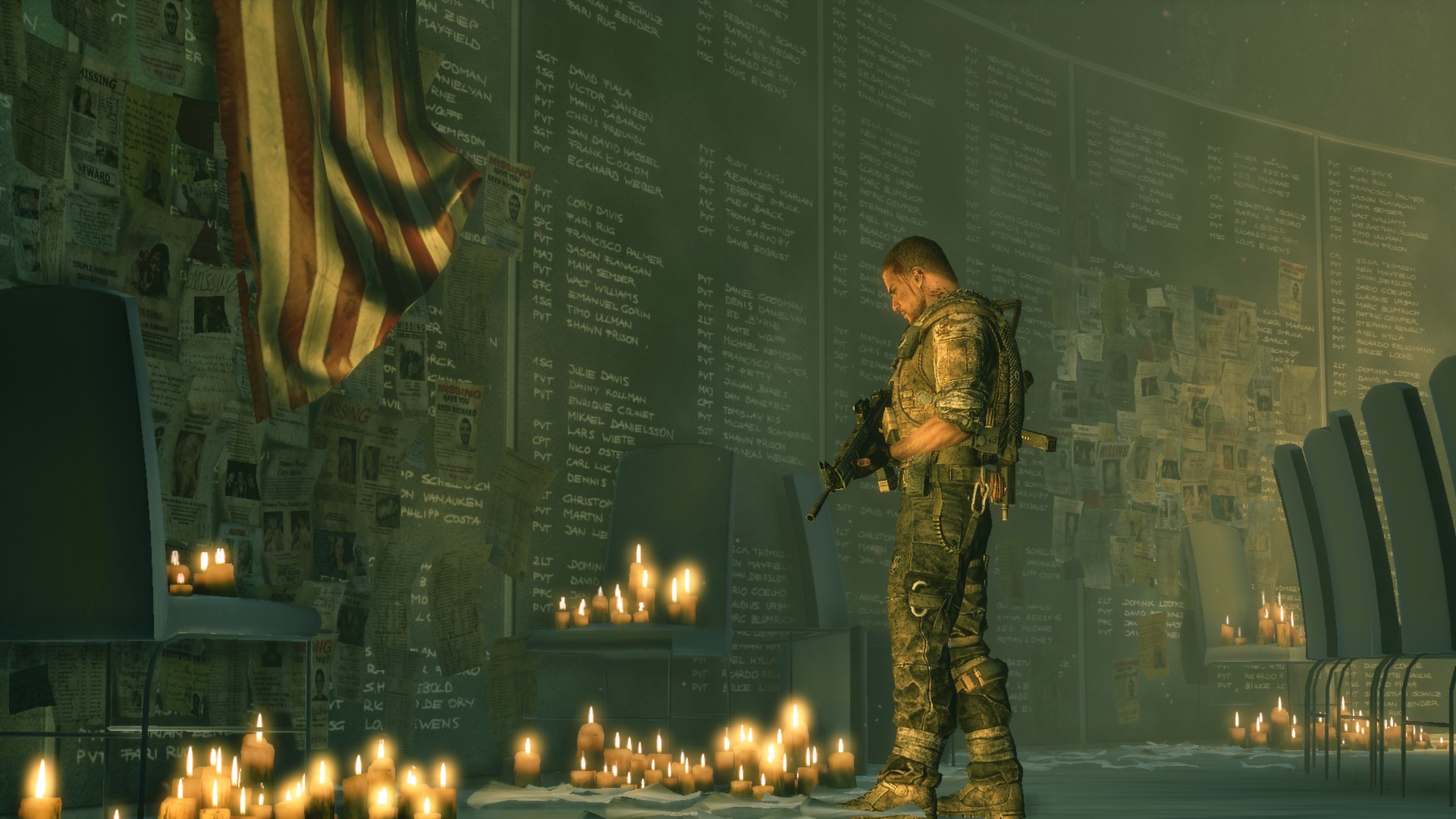
This intensity increases as Walker begins to experience hallucinations. His mental clarity deteriorates and his whip-sharp orders and the clinical precision of his actions devolve into angry shouts at his squadmates and brutal executions of enemy combatants, wonderfully brought to life by voice actor Nolan North.2 This self-awareness of the genre in which the game itself exists—where players essentially take delight in the death of other people by their own hand (of course it’s way more complicated than that)—is what gives the game its unique perspective.
It almost becomes a detriment, actually, because while on the one hand it urges you to lay down your weapon, on the other, it offers no possibility of doing so while also completing the game. You must riddle holes through an endless onslaught of enemies no matter what. In one of the more brutal sections of the game, you find yourself pinned down by snipers. It appears as if there are options for rappelling down from your hiding spot and sneaking through or potentially eliminating the snipers; but the rappel lines are inactive and the snipers infinitely respawn (your bullets don’t). The only option is to drop white phosphorous on your enemies, and the checkpoint cannot be completed until you “accidentally” take out several dozen innocent civilians. That’s not me making a tough choice. That’s the game developers cheaply forcing their point. It’s horrifying, sure, but it should not make the player feel guilty for having done it.
There are a few scripted opportunities where the player can avoid firing a bullet. For the most part, though, the game’s intentional questioning of the need for violence comes from the dialogue. The three main characters develop a camaraderie through cuss-laden banter that makes their brotherly love-hate relationships believable. Many of the cutscenes show the three main characters waging war inside their own heads and pressing one another for answers that simply don’t exist. Other times, you’ll hear enemy characters say offhand remarks that refreshingly don’t paint them as purely evil. Of course, when you know those enemies will kill you in 0.3 seconds flat if you peak out of cover on the FUBAR difficulty (effed up beyond all recognition), you don’t really think about it anymore.
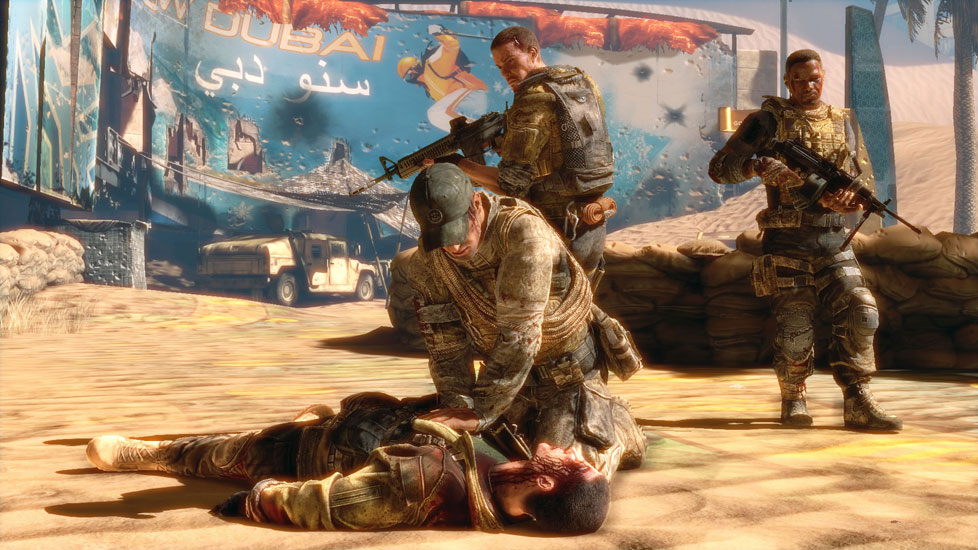
In that respect, the game is “just another military shooter.” The cover-based combat is unremarkable; serviceable but routine duck-peek-fire shooting for experienced gamers. There are a few nice wrinkles that give it some distinction. Grenades thrown onto sand-covered areas will kick up clouds of dust, submerging everyone in a haze and allowing the player to maneuver positions or pick off a handful of enemies all at once. Whenever enemies are downed, sometimes they squirm around before they bleed out, and the player has a brief window to execute them; doing so will net the player an extra magazine or two and sometimes a grenade.
All is well on the game’s lower difficulties, where your fragile human frame can take a hearty helping of lead before you succumb. Not so on FUBAR, where the game’s lack of refinement means you’re in for a frustrating slog. Too often you’ll find that you’ve popped out of cover without meaning to, or merely sprinted and stood next to a wall rather than engaging with it, and on the highest difficulty staying in cover is a must. The same button is responsible for sprinting, going into cover, and healing your teammates; and a different one has both melee and vault-over-cover mapped to it. This can make for annoying blunders when the game misinterprets your intention in pressing these, and on a higher difficulty those mistakes are often fatal. The checkpoints are punishingly spread out at certain points, further exasperating this issue.
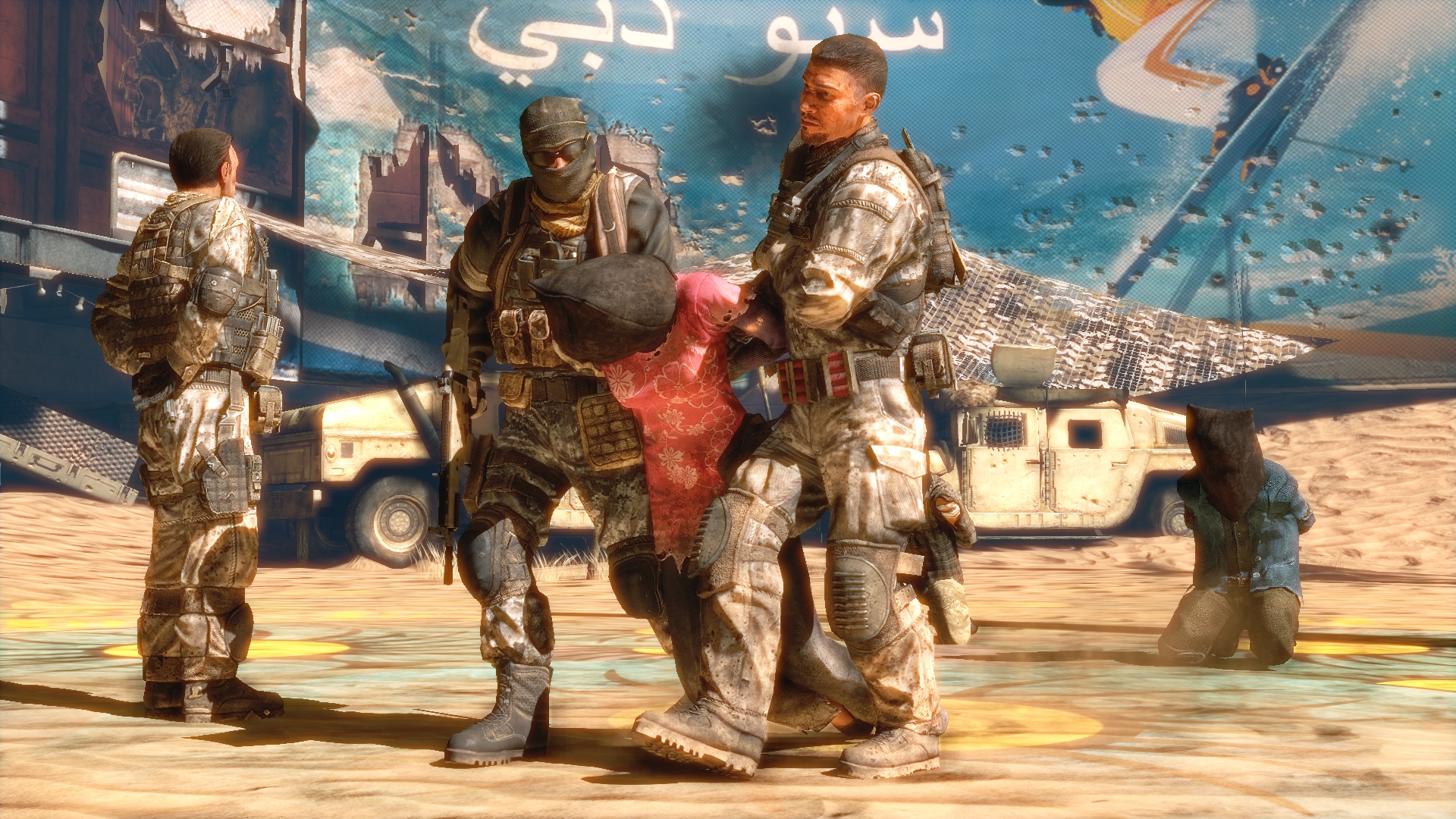
The game is incredibly linear, not really even pretending to offer variations in tactics. There are only a few instances where a different strategy is viable for clearing an area, and even the choices that are thrust upon the player to make them feel awful about themselves are of no consequence to the narrative as a whole. There are rudimentary squad commands (target a certain enemy, tell one teammate to heal the other), but the friendly AI is hit-or-miss. One of your soldiers carries a sniper that comes in handy pretty frequently, the other routinely breaks cover and gets himself gunned down in the middle of the battlefield.
It certainly took a good bit of chutzpah to make this, and I think in some respects it pulls off what it set out to do. Most modern shooters gleefully put the player into the combat boots of an action movie hero. Spec Ops is a more thoughtful game, one that looks beyond the superficial, one that is worth your attention if you have the stomach for it. That being said, I can’t help but wonder if it is even appropriate to couch a critique of military violence inside of a game where the majority of your time is spent corralling noggins into your aiming reticle and pulling the trigger. The great works of art that inspired it are definitely worth your time; maybe this is too.
1. A very overt nod to Joseph Conrad’s Heart of Darkness, which was the inspiration for Francis Ford Coppola’s Apocalypse Now.
2. The other voice actors are terrific, too, and the sound design in general is very good. One of my favorite parts of the game is when you fight your way through an abandoned club that is blasting Deep Purple’s ‘Hush’ from jury-rigged homemade speakers.
Sources:
Cooper, Hollander. “Spec Ops: The Line – Learn about the story with lead writer Walt Williams”. GamesRadar. 30 March 2012.
Hari, Johann. “The Dark Side of Dubai”. The Independent. 7 April 2009.